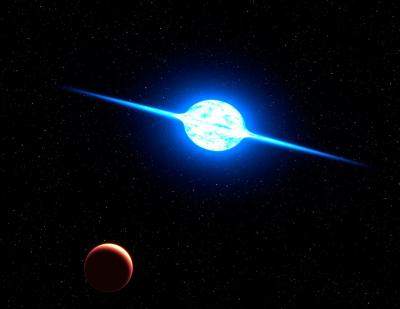An international team of scientists has discovered the fastest-rotating massive star ever recorded.
Dubbed VFTS 102, the star spins around its axis at an impressive 600 kilometers per second at the equator – a rotational velocity so high that the star is nearly tearing itself apart due to centrifugal forces.

The star is located in a region known as the Tarantula Nebula. It is extremely hot and luminous, shining about 100,000 times more brightly than the sun.
According to astronomers, VFTS 102 had a violent past and was likely ejected from a double star system by its exploding companion star.
So how do stars such as VFTS 102 reach such rapid rotation?
Astrophysicist Matteo Cantiello, a postdoctoral fellow with UC Santa Barbara’s Kavli Institute for Theoretical Physics, explains that a star can achieve high rotational speeds by engaging in a “cosmic dance” with another star so close that gravity strips gas from its surface.
“This gas falls onto the companion star, increasing the mass and spinning it up,” he said. ”Similar to a tennis ball spinning fast after being hit by a glancing blow, a star rotates quickly after being hit off-center by the in-falling gas.”
However, Cantiello notes that VFTS 102 is unusual not only because it rotates so fast, but also because it is moving away from its neighboring stars at a velocity of about 70,000 miles per hour, or 30 kilometers per second.
“Having been part of a binary system could explain this space oddity. It has been known for over 40 years that a star in a massive binary system can be shot away from its surroundings when the companion ends its life in a spectacular explosion called a supernova,” said Cantiello.
“In our theoretical calculations we noticed that the ‘spun-up’ star would also be moving from its surroundings at a high rate. It is very exciting to find a star that matches both of these predictions.”
The astronomer added that VFTS 102 may produce dramatic fireworks as it dies. To be sure, such a rapidly rotating, massive star is believed to be the progenitor of some of the brightest explosions in the universe: gamma-ray bursts which occur when the star’s fast rotation produces powerful jets of light and matter.






